Injera
Injera – Quick and easy spongy, crepe-like flatbread that’s slightly sour, slightly sweet, and utterly addictive.
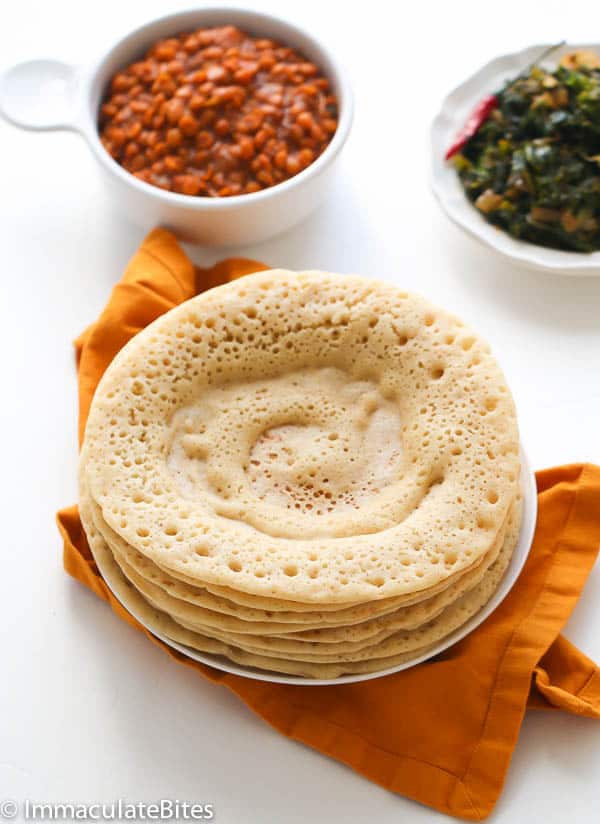
I remember a time in my life, (my broke and ignorant college days) when I be-grudgingly ate injera, at least once a week. You see, I had this Ethiopian roommate that could not have a meal without Injera. Why the HECK would anyone pick sour spongy bread over fresh Baguette? Sadly, at that time, I did not get it.
And to add salt to injury, 9/10 times when it was her turn to pick out a place, to eat, it would be at an Ethiopian restaurant. I just couldn’t bring myself to say no, she was really sweet. It was one of those things that kept her going. So I kept it civil and accepted politely. Yes, after eating it so many times, it quickly grew on me.
To this date; I crave it and make a stop at my favorite Ethiopian restaurant to pick up a plate of food with Injera. The funny thing is, my family doesn’t get it either. Fyi, they are a lost cause. So never attempted to make one at home until now.

What is injera?
Injera is a Flat round fermented sourdough bread- bread like no other, with a unique, slightly spongy texture. Always present during mealtime, in countries like Ethiopia, Eritrea, Somalia, Yemen, Djibouti and Sudan with each country having its own variation.
What is injera made of?
Different variants of this dish use different mixes of ingredients. For my very own Immaculatebites version, I used the following ingredients:
- Corn flour – Made from finely ground dried corn.
- Sorghum – An ingredient native to Africa. its usually used to make cereals and alcoholic beverages. You can use whole wheat in place of this ingredient.
- Sugar – Common table sugar you can easily find in any grocery store.
- Dry Yeast – This ingredient helps make our dish light and airy. Use warm water to activate it.
- Warm Water – An essential part of making any dough. It’s the basis for forming our treat. This activates the yeast. Use the right warmth to activate the yeast.
- All Purpose Flour – This pantry must-have isn’t just for baking. it’s also great for many savory dishes.
- Baking Powder – An instant ingredient that helps our dough rise. it’s basically sodium bicarbonate. it reacts well with acid.
- Salt to taste
I am not going to lie, making authentic Ethiopian injera, with Teff flour is no Joke and not for the faint of heart. I tried several variations. Comparing it to restaurant quality injera. But it’s just too tedious and involved, even for a seasoned cook.
Recipe Variation
At one point, I could just picture the look on my sister’s face, and the words coming out of her mouth. “So expect me to make this! No thanks.” Quickly decided against it- for now. One of these days am going back to it.
I settled for this Somalia Version, instead (known as canjeero or lahooh) somewhat similar in taste to injera, fairly easy and better tasting than some of the Injera’s I tried making at home. Good enough to be an edible plate and sturdy enough to scoop up stews.
This right here, is a great introduction into the world of sour dough spongy flatbread and ANYONE can make it-Scout’s Honor. And you don’t need a special pan for this-just make sure it’s a non-stick pan. For those that enjoy the sour taste you can let it ferment after 2 hours and then refrigerate overnight. The flavor intensifies and renders the dough sour.
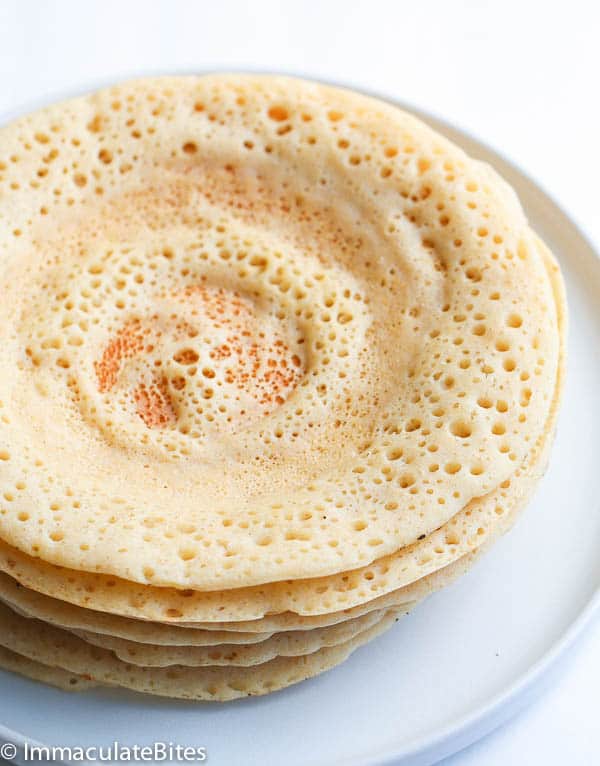
I adapted this Injera from this lovely couple here, they share Amazing Somalia recipes- do check them out if you want to learn how to make more delicious Somalia recipes. And also got a few hints here
This might not be authentic Ethiopian injera but it’s good enough to make again and again, and it’s even got a thumbs up from hubby.
What to eat with Injera?
An added bonus is that you can sweetened things up with cinnamon sugar, honey and this spiced butter here . Then enjoy as a breakfast item, snack, or dessert. Believe me, you are not going to want to stop.
A Great flatbread to have on hand when making Doro Wat. BOY! the two eaten together DIVINE! Get the recipe for Doro Wat Ethiopian Chicken Stew.

Tips and Tricks
- Make by hand for smooth batter – Is preferable to make injera by hand , so you get a feel of the batter. Start by adding a cup of water at a time to make a smooth batter.
- Flour Substitute – Traditionally this injera is made with sorghum flour. However, you may substitute the sorghum flour with whole wheat flour. Barley flour works as well.
- Humidity Consideration – Keep in mind that humidity, flour and water do play a role in making this injera.Injera should be thicker than a crêpe, but not as thick as a traditional American pancake.
- Self Rising Flour Replacement – You may replace the flour , salt and baking powder with the same amount of self rising flour as it’s customary.
How to make Injera?
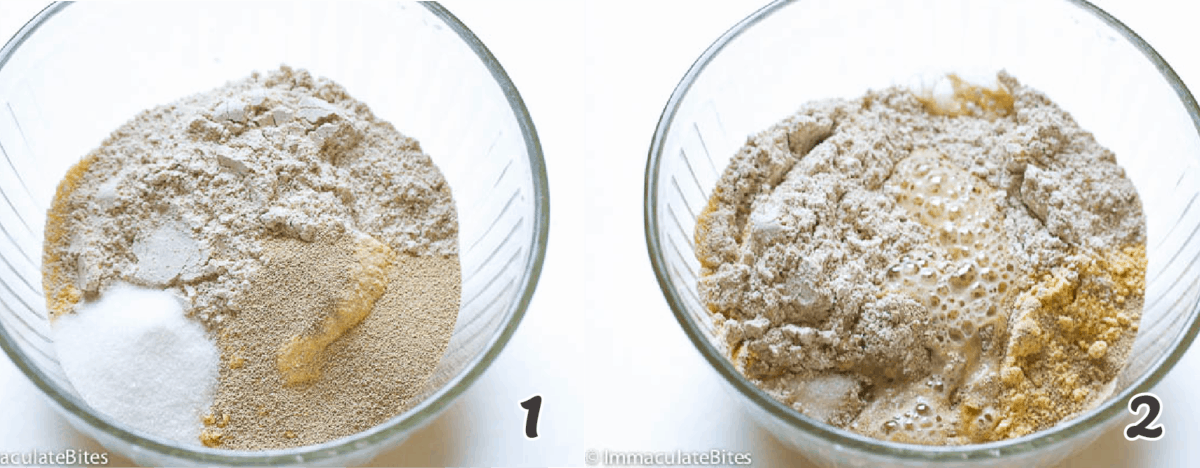
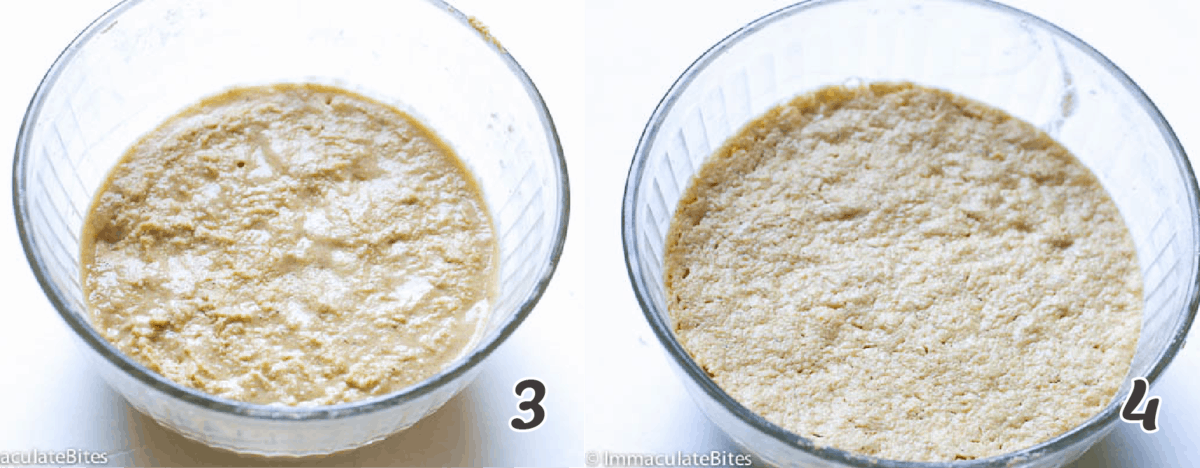
- Combine corn flour, sorghum, sugar, yeast, and water. Mix and let it rise (See photos 1-4)
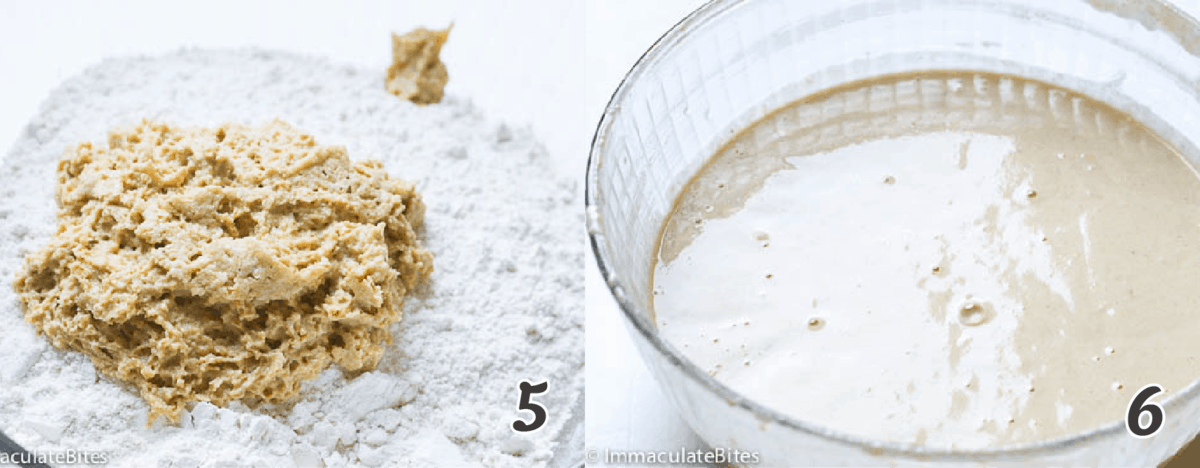
- In another large bowl, combine flour, salt, and baking powder and sugar
- Add the starter mixture to the flour mixture. Thoroughly mix and start adding water a little at a time until water has completely been used up, thoroughly mix to eliminate any lumps. You may use a blender to aid the process (See photos 5-6)
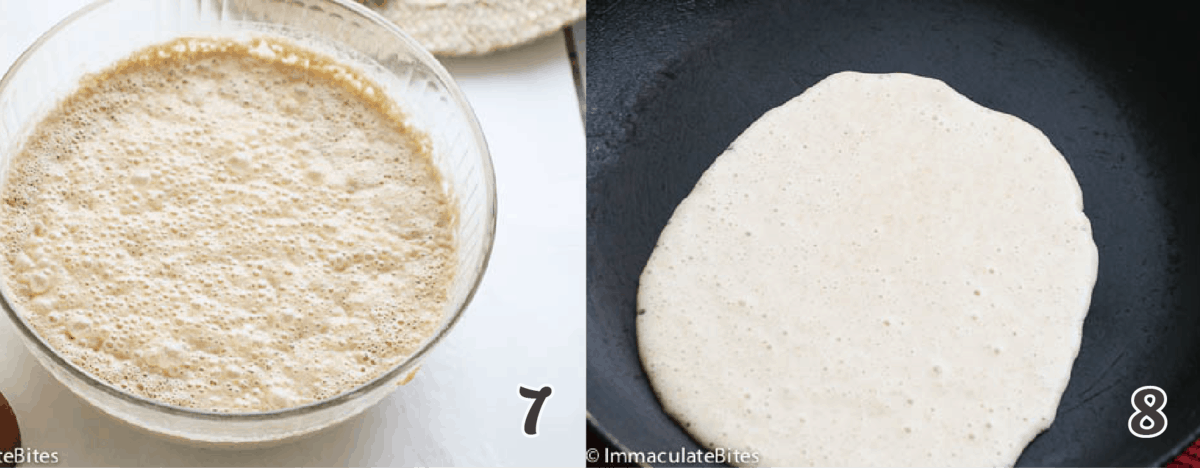
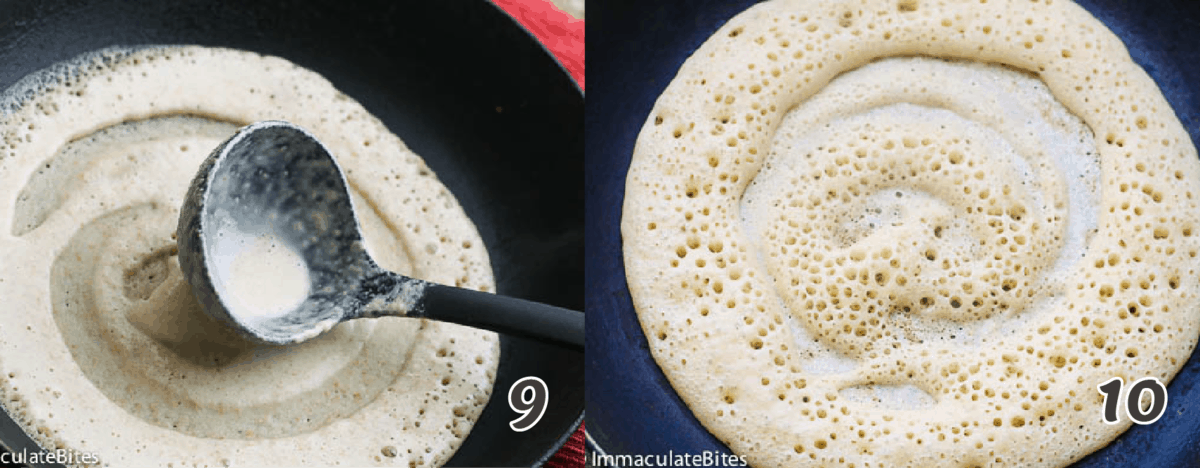
- Let it rise for about 2 hours (See photo 7)
- Heat a skillet, crepe pan, or non-stick fry pan preferably one with matching lid to medium high heat.
- When ready to cook, pour a ladleful (about 3/4 cup or more) of injera batter. Spread in a circular motion about the size of a dinner plate. Covering it with the lid shortens the cooking time. (See photo 8-9)
- Let it cook until all batter forms little brown spots coming through. No need to turn the batter. (See photo 10)
- Transfer to a plate with a spatula. put aside and continue cooking until you use up all the batter.

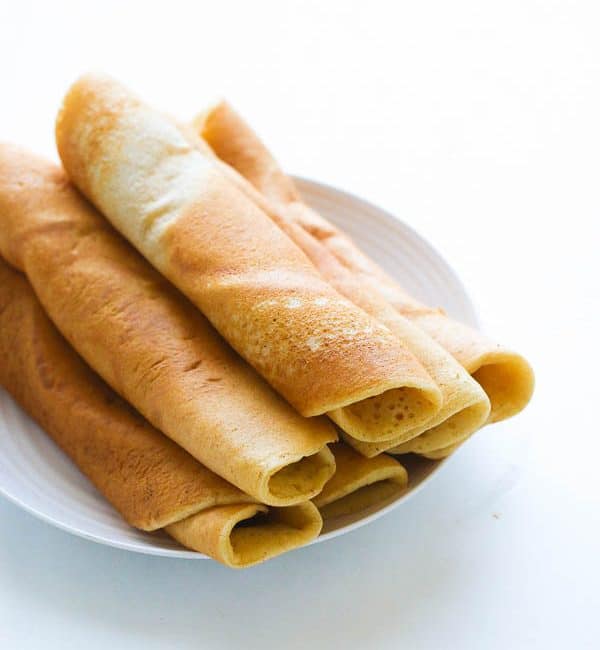
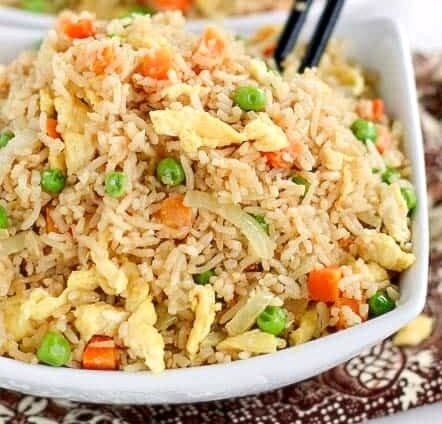
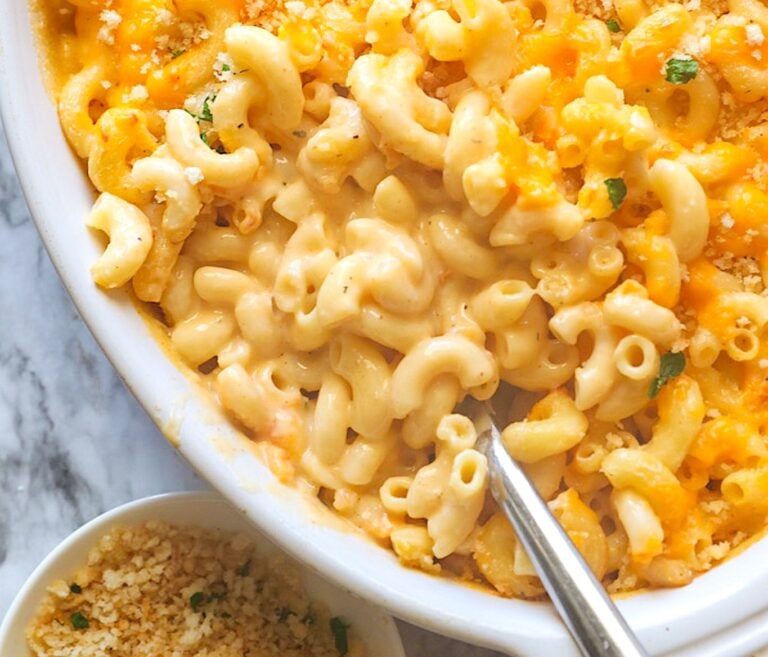


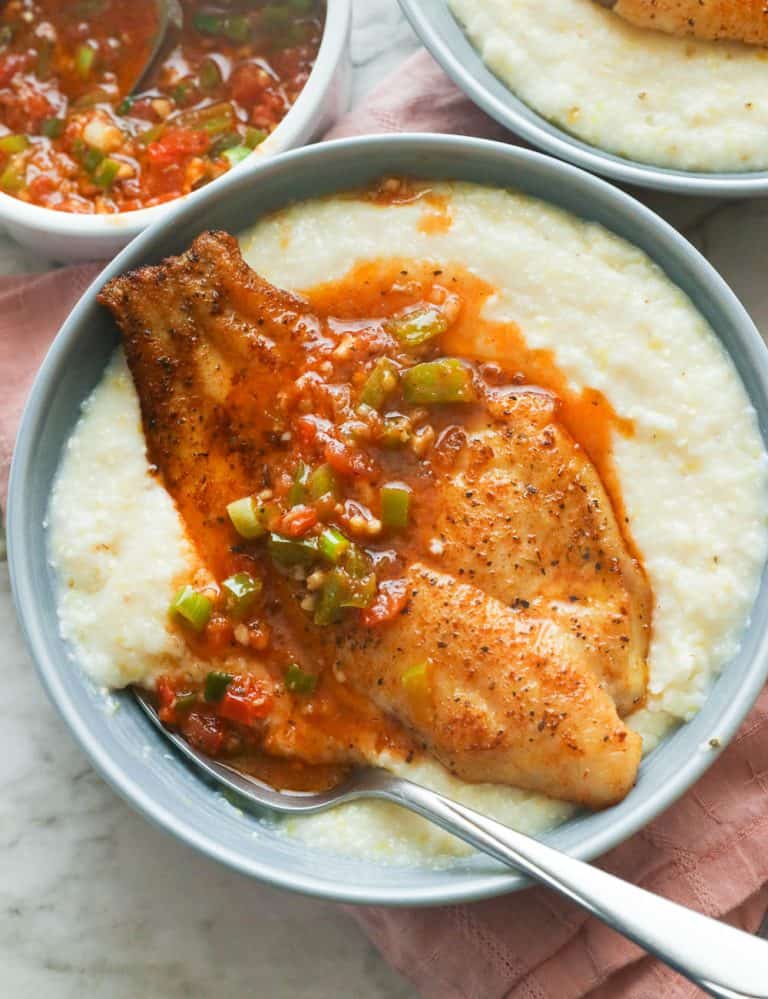
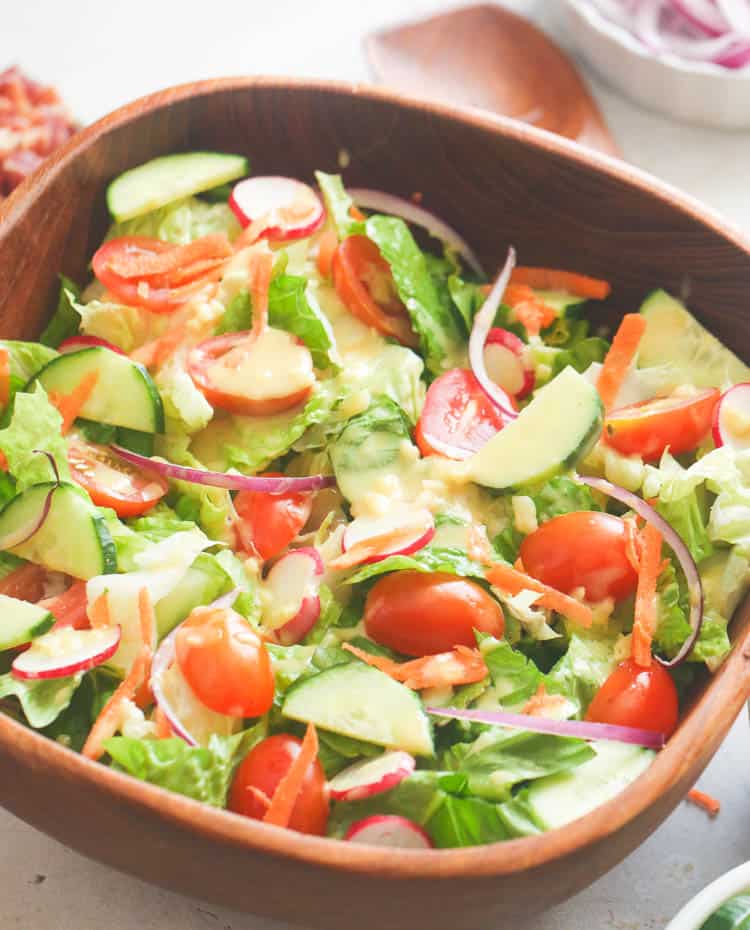
Thanks so much for this recipe! I love injera, but we don’t get teff flour here in soith Africa, and anyway, the process of making the real mccoy is just too time-consuming. This recipe looks very do-able and I’m definitely going to try it out ehen making my bozena shiro or doro wat.
Awesome! Do let me know how it works out for you.Thanks!
I fell in love with Ethiopian food when travelling and I’m so grateful for your recipes. I was really craving ethiopian food and now I make it myself thanks to you! It’s always my go to for dinner parties and my guests are always so impressed. Thank you ❤️
That’s wonderful to hear Catherine! Thank you for taking the time to share this with me.
I was a little confused by your instructions for making it extra sour. Are you saying after it’s all mixed up to let it sit for two additional hours and then refrigerate over night? Thanks!
Yes, to get it extra sour you do have to let it sit over-night. The first two hours is to get it to rise.
Hi, I’m looking online for sorghum wheat flour & only seeing white “sweet” sorghum flour or sorghum “grain.” Would either of these work? Thanks for the recipe!
Hi Amy! Yes it would! Do let me know how it works out for you! Thanks
Hi from down under tried your injera today, I used 1 cup teff flour instead of corn flour and 1/2 cup corn flour in stead of sorghum whole wheat , then followed your recipe exactly. Fantastic turned out just delicious, kids had some as pancakes , and we will have some for dinner with beef curry and dhall. Great instructions. Just wished I had a large injera pan , ended up making 28 just bigger than side plate size.
Thank you so much for the detailed feedback Jean! Glad to hear it worked out well for you.
also, this looks gorgeous but the serving size makes it very difficult for me to try this for myself
You can divide in half or thirds reduce the quantity.
typically corn flour means corn starch
Corn flour is mainly used for baking and fritters and it’s often used in combination with other flours While .Cornstarch is mostly used as a thickener
Can I substitute teff for the barley flour?
You sure can.
Just made these! The batter turned out a little thicker then yours but I kept myself from adding more water and just continued with and they turned out sooo good! They have such a nice bread flavour that I remember from being a kid. Thank you sooo much!
Awesome! Glad to hear it worked out well for you.
Great recipe! I’ve never had injera before, but I made the blender version of your recipe, and it looked just like your pictures. Tasted great with the doro wat and lentils. Feeling proud of myself haha! Can’t wait to try more of your recipes. Pictures are beautiful!
Thank you so much!!! Glad it you enjoyed both recipes. Happy Holidays!!!
As an Ethiopian American who goes home every year, I try to make injera and I would say its an impossible bread to make consistently well. Anything from the flour to the temperature or the starts can wreak havoc on a well followed recipe. In fact most Ethiopians living in the US or elsewhere buy their injera. They either buy it from Ethiopian/specialty stores or have it delivered. There are some good injera delivery sites you can use, like injeraforyou.com. mesob.come and I think also teffcompany.com delivers. Anyway, I commend anyone (Ethiopians and esp non Ethiopians) who try to make injera at home. bravo!
Would it be acceptable to cut up the chicken in small pieces so this is more of a thick chicken stew? I really enjoy how the restaurants just place mounds of different dishes on the big piece of injera and you pick up what you want with the little pieces of injera. No utensils needed!
Of course! you can even make it with boneless chicken .
I just realized I put this question on the wrong page. This is in reference to doro wat, just in case anyone gets confused. Thank you for your reply!
What is the Irish equivalent of corn flour and all purpose flour??
All purpose is regular flour . And corn flour is flour made out of corn.
Cornmeal. Corn flour is cornstarch in Ireland.
it was only last week that my dad (who had travelled through east africa some years ago) told me about a “weird bread” called injera which he had eaten in ethiopia. scrolling through foodgawker, i stumbled upon your recipe – i definitely have to try it!
greetings from austria
jana
Thanks for stopping Jana!Do let me know how it works for you, when you give it a try. Happy cooking!!!
I’m sure this is tasty, but traditionally, injera is made with teff flour.
This isn’t quite authentic 😉
It is clearly stated in the notes. Thanks for stopping by!
Perfect!! I love Ethiopian food and am so sad we don’t have an Ethiopian restaurant in Charleston. I thought about making some similar dishes at home and trying to make injera but when looking up recipes it seemed so involved. I will definitely be making this in the future and checking out some of your other recipes!! Thanks for sharing.
Totally agree Caroline! It is too involved this is a great recipe for a quick fix. Do let me know how it works out for you. Thanks
These look and sound so inviting, and if your a sourdough fan like myself I need to make this soon. Thanks Imma!
You are Welcome Kevin. Hope it works out for you.
What can I substitute the corn flour with?
Use whole wheat and all purpose flour. Or use corn meal and blend in a food processor or blender
Would you recommend to use 1 cup wholemeal + 1.2 cup rye flour for the starter dough? Or maybe 1 cup white all purpose flour + 1/2 cup wholemeal? There are many options I presume, I will try with 1 cup mixture of wholemeal/white + 1/2 rye, let’s see if it will work. But it would be nice to know what would you recommend as a specialist, if having to use only wholemeal,rye and white flour?
Thanks!
They would both do just fine. It all depends on your taste buds. And there’s no denying rye adds a healthy, flavorful kick to most baked goods.
I make my Indian version of injera by using black lentils (urad dal)to help ferment the teff flour. 1/2 cup of soaked ground lentils mixed with 2 cups flour and required water and left overnight to rise. Makes a pretty good batter!
Thanks for sharing your recipe, Savi! That sounds soo good! Might have to try your version some other time.
Looks like all the effort is worth it! Would love to try making this. What is it about using teff flour and making the traditional Ethiopian injera that is more complex than this version?
Traditional Ethiopian Injera takes about 3-5 days to make . This version takes about 2-hours to rise and about 10-15 mins prep, if using the blender.
Thank you so much for sharing this recipe! I’ve struggled for years and years to re-create the injera bread I’ve eaten at restaurants and this is the closest I’ve ever come to getting it right. Your recipe is delicious! Soft, pliable, spongy and perfect to soak up all the tasty gravy. I also opted to mix with my hands like you did and I think that made a HUGE difference. Thank you!
Am loving all your ethiopian recipes you have going on here. This is my kind of flatbread! So definitely going to give it a try
Thanks Sara! Please let me know how it worked out for you. Thanks for taking the time to share your thoughts.